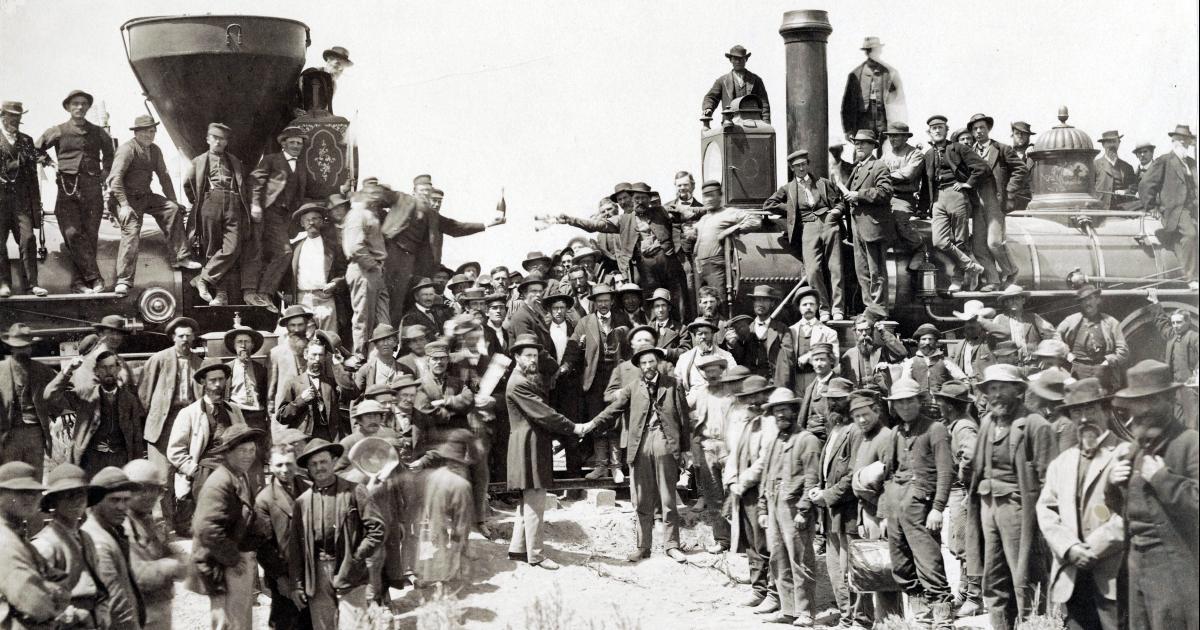Iron, Industry, and Injustice: The Race to Build America's First Transcontinental Railroad

On May 10, 1869, two railroads met in the middle of nowhere—and changed the nation forever.
The Dive
By 1869, the idea of a transcontinental railroad had been circling for decades. But it took a civil war—and a Congress no longer split between North and South—to finally move it forward. In 1862, the Pacific Railroad Act granted land and loans to the Union Pacific and Central Pacific railroads, launching one of the most ambitious infrastructure projects in American history.
From Omaha and Sacramento, workers began laying tracks toward each other across 1,776 miles of wild terrain. Irish immigrants, Civil War veterans, and freedmen worked the Union Pacific lines, while thousands of Chinese laborers took on the treacherous Sierra Nevada for the Central Pacific. Avalanches, dynamite accidents, heatwaves, and exploitation were routine. Chinese workers were paid less and given the most dangerous jobs—but without them, the railroad would not have been completed.
On May 10, 1869, the two lines met at Promontory Summit, Utah. Railroad barons gathered in suits and top hats to drive a ceremonial golden spike into the final tie—telegraph wires wrapped around the hammer transmitted the blows in real time across the country. In San Francisco and New York, cannon blasts marked the moment. For the first time, America was physically united from coast to coast.
The railroad transformed trade. What once took six months by wagon could now be done in six days. Crops, cattle, tea, textiles—goods surged back and forth, and industries boomed. But with this growth came upheaval. Native American lands were carved up and sold off. The railroad brought buffalo hunters who decimated herds Indigenous communities depended on. Entire nations were pushed onto reservations or wiped out altogether.
The transcontinental line also introduced the idea of standardized time zones, made possible catalog shopping, and seeded hundreds of new towns. It redefined the American landscape—and who had power within it.
But it was also an early case study in corporate manipulation. The railroad’s backers—Stanford, Huntington, Hopkins, and Crocker—pioneered government-financed capitalism, taking public subsidies while dodging accountability. And once the tracks were laid, the laborers who built them were discarded and often excluded from the prosperity they made possible.
Despite its human costs, the transcontinental railroad remains one of the most transformative feats in U.S. history. It changed how Americans moved, traded, and thought about space itself. And it laid the literal and metaphorical tracks for the next era of empire, industrialization, and American ambition.
Why It Matters
This wasn’t just a train—it was a transformation. The transcontinental railroad redefined travel, work, and what it meant to be American. But it also reminds us that progress often rides on the backs of the powerless. To understand the modern U.S., you have to understand what was built, who built it—and who paid the price.
?
How did the transcontinental railroad change travel and trade in the U.S.?
What role did immigrant labor play in building the railroad—and how were they treated?
How did the railroad affect Native American communities and the environment?
What were some of the unintended consequences of the transcontinental railroad?
Do you think the benefits of the railroad outweighed its costs? Why or why not?
Dig Deeper
A PBS-style documentary clip explaining how the railroad was built, who built it, and why it mattered.
A powerful short film telling the story of the thousands of Chinese immigrants who helped build the Central Pacific railroad—and how history left them out.
Related

The Gilded Age, Industrialization, and the 'New South'
A glittering era of innovation and industry, the Gilded Age promised progress but delivered inequality. In the South, leaders dreamed of a 'New South,' yet industrialization offered opportunity for some while reinforcing systems of poverty and discrimination for others.

The Market Revolution: How Innovation Transformed America
In the early 1800s, America changed from a land of small farms to a booming nation of factories, railroads, and markets. The Market Revolution connected people, goods, and ideas—while also revealing deep inequalities in who benefited from progress.

The U.S.-Mexico War
On May 13, 1846, the U.S. Congress declared war on Mexico. Behind the scenes? Land lust, slave politics, and a president with a map in one hand and a match in the other.
Further Reading
Stay curious!
